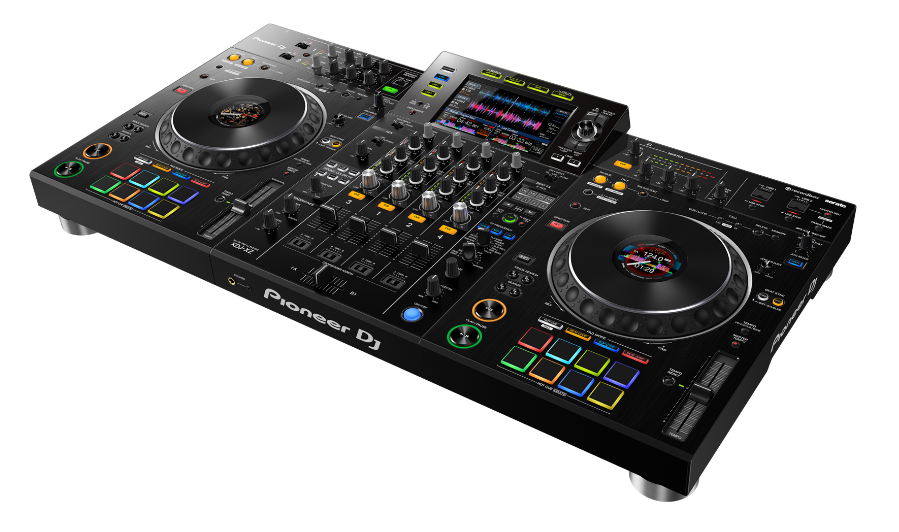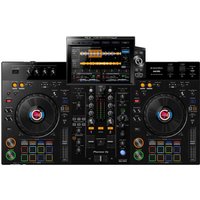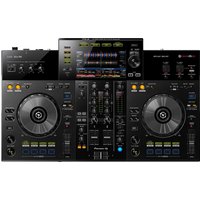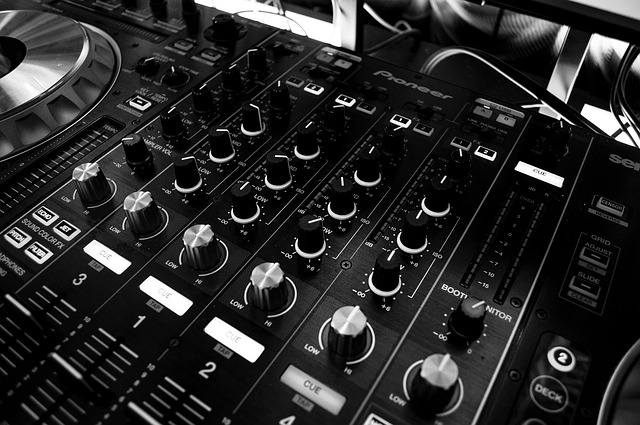The post Pioneer XDJ Controllers … Whats the differences? appeared first on Onthedex.
]]>
Pioneer are massive in the world of DJ equipment. Particularly in recent years, Pioneer dj controllers have started to take over the industry!
Pioneer have three XDJ controller units, that are marketed as all-in-one units. But what does that mean and what are the differences between these three excellent units?

The three Pioneer XDJ all in one controllers
What are the three all in one DJ controllers Pioneer offer? Heres a comparison chart for the three current Pioneer XDJ controllers.
| Feature | XDJ-RX3 | XDJ-XZ | XDJ-RR |
| No Channels | 2 | 4 | 2 |
| Display size | 10.1 inch | 7 Inch | 7 inch |
| Mic input | Yes | Yes | Yes |
| USB Ports | Yes | Yes | Yes |
| Jog wheel size | 6 inch | 8 inch | 7 inch |
| Pads | 16 Multicolor | 16 Multicolor | 8 Multicolor |
| Analog inputs | 2 x XLR-1/4″ Combo (mic), 3 x Dual Stereo RCA (line), 2 x Dual Stereo RCA (phono), 1 x 1/8″ (aux) | 2 x Dual RCA Stereo (phono), 2 x Dual RCA Stereo (line), 1 x Dual RCA Stereo (aux), 2 x XLR-1/4″ combo (mic) | 1 x Dual RCA Stereo (phono/line), 1 x XLR-1/4″ combo (mic) |
| Analog outputs | 2 x XLR (master 1), 1 x Dual Stereo RCA (master 2), 2 x 1/4″ (booth) | 2 x XLR (master), 1 x Dual RCA Stereo (master 2), 2 x 1/4″ (booth), 2 x 1/4″ (send) | 2 x XLR, 1 x Dual RCA Stereo |
| Software | Rekordbox DJ, compatible with Serato DJ Pro | Rekordbox DJ, compatible with Serato DJ Pro (firmware update), Rekordbox Video (sold separately), DVS Control | Rekordbox DJ |
| Effects | 14 x Beat FX, 6 x Sound Color FX | Color FX: Space, Dub Echo, Sweep, Noise, Crush, Filter ; Beat FX: Delay, Flanger, Helix, Phaser, Ping Pong, Pitch, Slip Roll | Echo, Reverb, Flanger, Filter, Noise, Dub Echo, Pitch |
| Price | Currently priced at $2,099.00 or £1,700.00 if in UK. | Currently priced at $2,499.00 or £2,049.00 if in UK. | Currently priced at $1,049.00 or £1,030.00 if in UK. |
(Note all prices current as of January 2024)
XDJ-RX3

This all-in-one digital DJ system is a blend of intuitive hardware and flexible software. It’s designed for a 2-channel setup. The system features 16 multicolored pads, which are great for creative performance. A 10.1-inch touchscreen display enhances the system. This display provides excellent visual feedback for mixing. It also simplifies browsing through tracks.
The system includes Nexus-style features like Quantize, Beat Sync, and Slip Mode. These features help DJs achieve polished results easily. It offers Sound Color FX and Beat FX to add flair to mixes. Another feature is the Loop Slice. This allows DJs to slice loops and remix them using hot cue pads.
The system supports rekordbox DJ and Serato DJ Pro software. DJs can prepare tracks in rekordbox with cues, loops, and beat markers. Dual USB inputs allow loading music in formats like MP3, AAC, WAV, AIFF, and FLAC.
It also has phono/line inputs for external sources like turntables and media players. Dual mic inputs include XLR and 1/4-inch connectors. This caters to different microphones. Finally, the system offers full MIDI support via USB. This feature allows for control of DJ software.
XDJ-XZ

This 4-channel all-in-one DJ system is innovative and inspired by Pioneer’s NXS2 setup. It’s the first to support Pro DJ Link, enhancing its functionality with CDJs and Pioneer DJ gear. The system comes with 14 Beat FX and 6 Sound Color FX. These features offer a wide range of creative possibilities for DJ sets.
The system is designed for collaborative performances. It allows connecting up to two laptops at once. This feature facilitates back-to-back performances and smooth DJ transitions. The mic input includes a feedback eliminator for clear vocals. The system’s sound quality is exceptional, thanks to 64-bit digital signal processing.
A Master 3-band EQ is another key feature. It lets DJs fine-tune their output for any environment. The system also has 16 performance pads. These pads trigger software-specific features, adding control and interactivity. Side grab handles make the system portable.
The 7-inch LCD touchscreen and color On Jog Displays provide excellent visual feedback. The package includes the XDJ-XZ system, power cord, and USB cable. It also comes with a Quick Start guide, software license notice, and rekordbox dj license key card. This ensures DJs have everything they need to start mixing immediately.
XDJ-RR

This 2-channel all-in-one digital DJ system merges intuitive hardware with flexible software. It’s ideal for DJs who want a mix of both. The system has a 7″ display for exceptional visual feedback. This makes mixing effortless and track browsing quick and easy.
The system enhances DJ sets with its Sound Color FX and Beat FX. These features allow DJs to add unique elements to their mixes. The Loop Slice is a standout feature. It lets DJs carve and remix loops in real time using hot cue pads. This feature brings a dynamic and improvisational feel to performances.
The system includes a rekordbox dj software license. Rekordbox dj is popular for music management and performance. It allows DJs to prepare tracks with cues, loops, and beat markers in advance.
The system has dual USB-A ports. These support various music file formats like MP3, AAC, WAV, and AIFF. DJs can load tracks from flash media and mobile devices. Additionally, there are phono/line inputs. These inputs allow mixing external sources like turntables and media players.
The system also has a mic input with XLR and 1/4″ connectors. This caters to different microphone types. Full MIDI support via USB is another feature. It gives DJs more control over their DJ software. These features make the DJ system versatile and powerful for both aspiring and professional DJs.
Which to choose?
Ultimately your choice is going to come down to your budget. There is quite a difference between the prices. In particular the RR version is a lot chepaer than the other two. But depending what you are going to use it for, this unit might fit the bill.
Whichever you choose, you will get Pioneer DJ’s excellent build quality and reliability. All three units are excellent, professional audio controllers that any DJ would be happy to own.
CHECK PRICES AT ZZOUNDS
The post Pioneer XDJ Controllers … Whats the differences? appeared first on Onthedex.
]]>The post Beginner’s Guide to Choosing Your First DJ Mixer appeared first on Onthedex.
]]>
Welcome to the thrilling world of DJing! As a beginner, one of the most crucial decisions you’ll make is selecting your first DJ mixer. This guide is designed to help you navigate the sea of options and find a mixer that not only fits your current needs but also supports your growth as a DJ.

Understanding DJ Mixers
Before diving into the specifics, it’s important to understand what a DJ mixer is and its role. A DJ mixer is the heart of a DJ setup, allowing you to blend tracks, adjust levels, and add effects. It sits between the turntable or controller and the amp.
It’s where the magic happens – the blending of tracks to create a seamless musical journey.
Key Components of a DJ Mixer
A DJ mixer, as the centerpiece of your setup, comprises several crucial components that collectively define your mixing capabilities. Let’s delve deeper into each of these components:
1. Channels
- Function: Channels are the pathways through which audio signals from different sources (like turntables, CDJs, or digital audio from a laptop) travel.
- Usage: Each channel has its own set of controls. You can play a track from one source on one channel and another track from a different source on another. This separation allows you to independently manipulate different audio sources, a fundamental aspect of DJing.
2. Faders
- Function: Faders are sliding controls that adjust the volume of each channel.
- Usage: By moving a fader up or down, you increase or decrease the volume of the corresponding channel. Faders are essential for smoothly transitioning between tracks, managing the overall mix’s dynamics, and ensuring that no one element overpowers the others.
3. Crossfader
- Function: The crossfader is a horizontal sliding control that allows you to blend or switch between two channels (usually assigned as left and right).
- Usage: This is crucial for transitioning between tracks. By sliding the crossfader from one side to the other, you can smoothly transition from playing one track to another, creating a seamless flow in your set.
4. EQ Controls
- Function: EQ (Equalization) controls allow you to adjust the balance of frequency ranges – typically low (bass), midrange, and high (treble) frequencies.
- Usage: By tweaking these controls, you can shape the sound of each track. For example, you might reduce the bass on one track while increasing it on another to create a balanced mix. EQs are vital for blending tracks harmoniously and managing how different elements of each track interact with each other.
5. Effects (FX)
- Function: Many mixers come with built-in effects like reverb, echo, phaser, flanger, and more.
- Usage: Effects can add depth, texture, and excitement to your mix. You can use them subtly to enhance the music or more prominently to create dramatic transitions or highlight certain parts of a track. Understanding how and when to apply effects is a skill that adds to your unique style as a DJ.
Choosing the Right Mixer
1. Identify Your Needs
- Skill Level: Are you just starting, or do you have some experience?
- Music Genre: Some mixers cater to specific genres with their features.
- Future Goals: Consider where you want to take your DJing.
2. Budget
DJ mixers range from affordable entry-level options to professional-grade mixers. Set a realistic budget, but remember, investing a bit more can offer longevity in terms of features and build quality.
3. Features to Look For
- Number of Channels: Most beginners start with two, but four can offer more flexibility.
- Quality of Faders and Knobs: Look for durability and smoothness.
- Built-in Effects: Useful for adding creativity to your mixes.
- Connectivity: Ensure it has the necessary inputs and outputs for your setup.
- USB/MIDI Compatibility: Great for integrating with DJ software.
Additional Considerations
- Build Quality: A well-built mixer can withstand the rigors of DJing and last longer.
- Layout and Ergonomics: The layout should be intuitive, and controls should be easily accessible for smooth operation.
- Inputs/Outputs: Ensure the mixer has the necessary connections for your setup, including inputs for turntables or media players and outputs for speakers and recording.
Top Beginner-Friendly DJ Mixers
- Pioneer DJ DJM-250MK2: A great all-rounder with built-in soundcard.
- Numark M6 USB: Affordable and versatile with four channels.
- Allen & Heath Xone:23: Known for its sound quality and robust build.
Learning to Use Your Mixer
1. Understanding the Layout
Familiarize yourself with the layout of your mixer. Knowing where each control is and what it does is crucial.
2. Practice Basic Techniques
Practicing DJing is an art form that blends technical skill with creative expression. One effective practice technique is to start with mastering the basics. This means spending time understanding your equipment, from the layout of your DJ mixer to the functionalities of your turntables or controllers. Begin by familiarizing yourself with beatmatching – the skill of aligning the beats of two separate tracks to play in sync. Use a mix of tracks you’re comfortable with and some unfamiliar ones to challenge yourself. Experiment with transitioning between tracks, focusing on smooth fader movements and timely EQ adjustments. Regularly record your sessions to identify areas for improvement, like transitions that could be smoother or track selections that could be more harmonious.
Once comfortable with the basics, delve into more complex techniques like scratching, looping, and using effects. Set aside specific practice sessions for each technique. For instance, dedicate time solely to experimenting with different effects, understanding how they alter the sound and mood of a track.
Moreover, actively listen to mixes from established DJs, noting their techniques, transitions, and how they build a set’s energy. This can inspire your style and give you new ideas to try out. Lastly, practice sessions should be consistent but also enjoyable. It’s essential to keep the passion for music alive, as it fuels creativity and innovation in your DJing journey. Remember, practice in DJing is as much about honing technical skills as it is about cultivating your unique sound and style.
3. Experiment and Listen
Experiment with different settings and listen critically to how they affect the sound.
Enhancing Your Skills
1. Online Tutorials and Courses
There are numerous online resources available to help you improve your skills.
2. Practice Regularly
Like any skill, regular practice is key to improvement.
3. Join a Community
Connect with other DJs to learn new techniques and get feedback.
Conclusion
Choosing your first DJ mixer is a significant step in your DJ journey. By understanding your needs, doing your research, and practicing regularly, you’ll be well on your way to mastering the art of DJing. Remember, the best mixer is one that feels right for you and helps you express your creativity.
CHECK PRICES AT ZZOUNDS
The post Beginner’s Guide to Choosing Your First DJ Mixer appeared first on Onthedex.
]]>